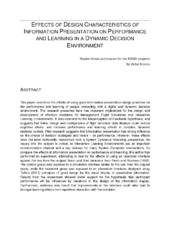Effects of design characteristics of information presentation on perfomance and learning in a dynamic decision environment
Master thesis
Permanent lenke
https://hdl.handle.net/1956/6164Utgivelsesdato
2012-07-09Metadata
Vis full innførselSamlinger
- Department of Geography [634]
Sammendrag
This paper examines the effects of using good information presentation design practices on the performance and learning of people interacting with a digital and dynamic decision environment. The research presented here has important implications for the design and development of effective interfaces for Management Flight Simulators and Interactive Learning Environments. It also connects to the Misperception of Feedback hypothesis, and suggests that better design and configuration of flight simulator data displays could reduce cognitive efforts, and increase performance and learning effects in complex, dynamic decision context. Prior research suggests that information presentation has strong influence on the choice of decision strategies and hence - on performance. However, these effects have not been sufficiently researched from a System Dynamics Modelling perspective. An inquiry into the subject is critical as Interactive Learning Environments are an important communication channel and a key delivery for many System Dynamics interventions. To compare the effects of information presentation on performance and learning, this author has performed an experiment, attempting to test for the effects of using an improved interface against the one from the original Boom and Bust simulator from Paich and Sterman (1992). The control group was exposed to a simulation interface similar to the one from the original paper, while the treatment group was exposed to an alternative interface, designed using Tufte's (2011) principles of good design for the visual display of quantitative information. Results from the experiment showed some support for the hypothesis that participant performance will be influenced by variations in the design of the information display. Furthermore, evidence was found that improvements in the interface could also lead to stronger learning effects from repetitive interaction with the simulator.
